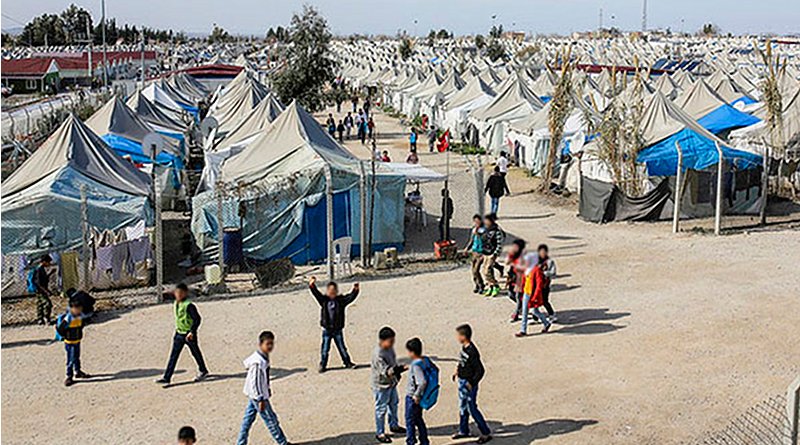Geographers Link Formation Of International Laws To Refugee Crisis
West Virginia University geographers are linking the political and human rights issues at borders today to the legacies of foreign and domestic policy across the globe since World War I.
Karen Culcasi and Cynthia Gorman, of the Department of Geology and Geography in the Eberly College of Arts and Sciences, have studied more than 100 years of international laws that have led, perhaps unintentionally, to the existing hostile climate for refugees.
“We have revisited the origins of why international laws were formed the way they were. It was to work against the dehumanizing ways in which people were depicted and then denied access to certain basic rights,” Culcasi said. “I think that’s something we constantly have to be vigilant about – the way in which certain individuals are identified as somehow not worthy of the same kinds of rights and protections you and I want to enjoy.”
While much research has been done on the long-term effects of the World War I peace negotiations, Culcasi and Gorman’s research examines how the Paris Peace Conference of 1919 and other historical moments connect to today’s refugee and border policies.
These connections range from the creation of new countries and the rise of nationalism to the establishment of international governance through entities like the League of Nations and the 1948 Universal Declaration of Human Rights.
Before World War I, migration was more fluid with fewer obstacles.
“There was a lot less hindrance then,” Culcasi said. “The idea of the refugee doesn’t exist in the way we understand it today without a state boundary to cross.”
With the fall of the Austrian, German, Hungarian and Ottoman empires following World War I, many new countries were established. This restructuring of the world’s borders created more boundaries – and obstacles – than ever before.
“Much of what came out of World War I was the concept that state, territory and belonging were all linked together. While this was relatively common in Europe, it wasn’t in the rest of the world,” Culcasi said. “It went from about 55 countries in the world to 90 over the course of a year.”
This structure laid the foundation for what eventually became refugee law after World War II, creating the definition of a refugee, or individuals who cross state borders to flee from persecution, and internally displaced individuals, or individuals who flee their homes but do not cross state borders.
“Ideas about the nation-state which arise at this time are fundamentally connected to how we think about displacement and forced displacement,” Gorman said. “Without nation-state boundaries, you wouldn’t necessarily have the need to regulate mobility in the same way.”
Created in 1920, the League of Nations, predecessor to the United Nations, was the first organization to manage and provide resources for refugees.
“It was the first time there was an international organization looking out for people who were migrating, fleeing for safety,” Culcasi said. “Normally, you never impose upon another state’s boundaries, and that territorial integrity is of highest priority. But there was a sense that the international community had an obligation in that they could intervene in situations like this.”
However, the League’s efforts only focused on certain populations and specific situations where individuals had been forced to leave due to war or persecution.
“The League’s definition of refugee was tied to specific situations and people who had been forcibly displaced,” Gorman said. “At this time, there wasn’t an attempt to define refugee status according to a universal threshold that would apply despite one’s ethnicity or nationality.”
Universal definitions for refugees did not come about until after World War II in the Universal Declaration of Human Rights.
“The Holocaust and other atrocities of World War II were a catalyst for the idea that individual nation-states should not have unchecked power to determine how they treat people within their territorial borders,” Gorman said. “There needed to be a threshold of rights that were protected, regardless of people’s situation or their identity, whether they were citizens or not.”
The Universal Declaration of Human Rights also included the right to petition for asylum in another country, which was later expanded in the 1951 Convention Related to the Status of Refugees.
“Both of these moments sought to create a universal definition of who is a refugee and who can seek asylum,” Gorman said. “While states have sovereign control over their territories and the populations that reside in their territory, there is a special class of people who, when they are forced to cross a border, have protections articulated in international law that all states are obligated to respect. It’s a check on the expression of state sovereignty and the power and abuses that can accompany that.”
In the 1980s, U.S. refugee law evolved during the Cold War. It specifically excluded Central Americans who were fleeing countries that were U.S. allies at the time, Gorman explained.
“There is an infrastructure of exclusion that was formed in the Cold War that continues to limit who can qualify for asylum in the U.S. today,” Gorman said. “It is now affecting people fleeing gang violence in Central America who are subject to this exclusionary history.”
These historical moments continue to influence border and refugee policies today.
“The closure of borders, but even the more behind-the-scenes limitations of different policies and practices on the ground that are hindering, deterring and excluding refugees from coming in, are a violation of the morals and the norms as well as the international laws,” Culcasi said. “In some ways, it really makes me stop and reflect on why we even have international law. What is the value of it? It sets precedent, goals and ideals to aspire to, overachieve or even fail.”

